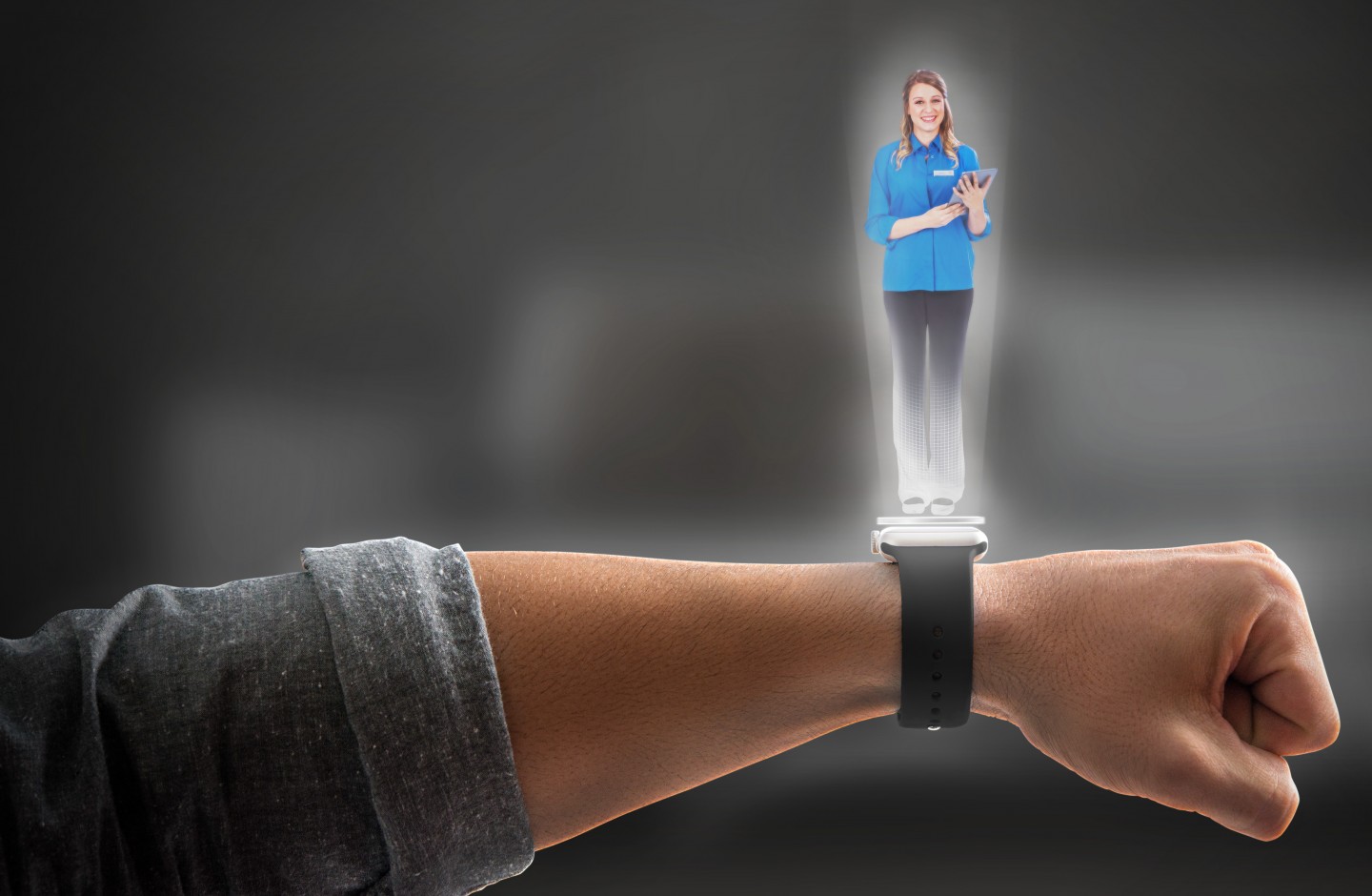In the early- to mid-90s, financial institutions began offering consumers their first taste of home banking services. Typically the consumer installed the PC banking program on their computer – most likely something equipped with an Intel® 486 processor – from the floppy disk or CD they picked up at their local branch (like one of our credit union locations in the Valley). After a few clicks and the “ping-ping-ping” of a dial-up modem, members had access to their balances, account histories, and the options of making transfers and paying bills.
Fast forward to 2015, and the world of financial services and digital banking has evolved beyond what many had imagined just two decades ago. Online banking has moved beyond the personal computer to the smartphone. Consumers now carry miniature computers – devices that are exponentially more powerful than their old, beige 1995 desktops – in their pockets, allowing them to access account information, make purchases, deposit checks, and transfer money to friends and family members. And with the advent of the smartwatch and other wearables, banking is moving to the wrist, with the ability to receive transaction and balance alerts, makes purchases, and locate nearby branches and ATMs.
Mobile, mobile & more mobile!
The smartphone has had a transformative effect on how we all interact with financial services, and Millennials – those born from approximately 1982 to 2000 – are leading that charge. In 2015 Millennials became the largest living generation in the United States, overtaking the once-dominant Baby Boomers. Millennials are digital natives – the first generation to grow up speaking the language of computers, video games, social media and the World Wide Web – and they will continue to have an impact on the digital banking landscape for years to come.
“Each year we are seeing branch activity continue to decline,” said Jason Paprocki, Arizona Federal senior vice president and Chief Experience Officer. “Between 2011 and 2015, branch transactions are down by 47 percent.”
More people are using their smartphones to take care of everyday transactions that used to require a trip to the branch. ATMs started the trend as a convenient way to obtain cash and make deposits, but now with a mobile app, consumers can check balances, transfer money, pay bills and even make deposits using the camera on their smartphones.
According to Paprocki, mobile deposit probably has had the biggest impact on branch traffic.
“Before, when the credit union introduced a new service like online banking or text alerts, members would use the new channel as well as old channels like branches and ATMs,” said Paprocki. “But mobile deposit has really eliminated the necessity to go to a branch or ATM.”
And the smartphone is just the beginning of the mobile revolution. The recent introduction of the smartwatch means consumers have more options for interacting with their financial data. Plus, other smart wearables on the horizon – like smart glasses, contact lenses and jewelry – will become more attractive, less obtrusive and easier to use.
Getting real with real-time alerts
According to Eric Givens, senior director of Digital Banking for Arizona Federal, real-time alerts and push notifications are two of the biggest benefits of the mobile revolution. Now consumers can get instant notices of transactions occurring on their accounts, helping them protect their accounts from fraud.
Givens recounts a recent time when he received a notification from a credit card company of potential fraud on his account. Using the mobile app, he was able to log in and confirm whether or not the transactions were valid. In this case, they weren’t.
“By the time I logged in, the fraudsters had already racked up $800 in charges,” said Givens. “And although I knew I wasn’t liable for those charges, the credit card company saved me a lot of headache by notifying me sooner rather than later. I had the whole situation wrapped up in 10 minutes while I was driving to a birthday party.”
Now the idea of push notifications is being taken even further, with the introduction of mobile apps that let consumers turn their debit and credit cards on or off, which is an ideal tool for preventing fraud and unauthorized transactions.
Ondot Systems, a Silicon Valley-based tech firm specializing in the mobile, security and payment industries, launched an app in early 2014 that provides consumers and financial institutions, including Arizona Federal, a robust tool for managing and protecting debit and credit cards.
“Not only can consumers turn their cards on and off,” said Vaduvur Bharghavan, Chief Executive Officer of Ondot Systems, “they can also set up other controls, like limiting the geographic area where their cards can be used, blocking certain merchants and transaction types, and setting dollar limits for transactions.”
With news of merchant data breaches a common occurrence, one of the added benefits of on/off apps like Arizona Federal’s CardPower™ is the ability for the cardholder to turn their card off while waiting for a replacement card in the mail. In the meantime, if the consumer needs to use the card, he can turn the card back on briefly to complete the transaction, and then turn it off again to prevent additional fraud.
“It’s a much better experience for the consumer so they are not stuck without a card and access to their accounts for an extended period of time,” added Paprocki.
Biometrics & digital wallets
Fingerprint readers and retina scanners were once the stuff of a James Bond spy thriller, but now they’re playing a role in digital banking. With the introduction of Apple’s Touch ID™, biometrics is now available to the masses for the first time.
Biometrics technology like Touch ID allows consumers to use their fingerprint to log in to their mobile banking apps, rather than having to memorize a password and experience the challenge of typing it on a tiny keyboard.
“Although the technology is cool and adds another layer of security, Touch ID is really about added convenience for our members,” said Paprocki. “It helps reduce the frustration of the forgotten password, and we’re seeing fewer members getting locked out of their accounts.”
And while Touch ID seems cutting-edge, Digital Insight, one of the largest providers of digital banking services to banks and credit unions, recently announced its partnership with EyeVerify, a biometrics technology firm. EyeVerify’s Eyeprint ID™ technology uses the camera on a mobile device to take an image and pattern-match the blood vessels in the whites of the eye, creating a unique digital key to unlock your mobile banking app.
Biometrics has benefits beyond mobile banking login security. The technology is also resulting in the growing popularity of the digital wallet. With Apple’s Touch ID and Apple Pay®, for example, consumers can make purchases using their smartphone and fingerprint, rather than using cash or taking a card out of their wallets. In addition, Google and Samsung are preparing to release competing digital wallets, Android Pay and Samsung Pay, making contactless payments available to even more consumers this fall.
Certainly one advantage of Apple Pay and similar services is that it uses a tokenization system, so the merchant never receives the consumer’s actual card number. If a hacker breaks in to a merchant’s data system, there’s no need to reissue a card.
Beyond fingerprints and “eyeprints,” other biometric tools on the horizon include heartbeat, iris and facial recognition technologies. All of these could eventually be used for logging in to accounts, authorizing payments and performing transactions at the ATM.
Advent of the digital financial coach
With more data than ever at our fingertips, the next big digital banking trend will be harnessing that information to help consumers with budgeting and financial planning. While money management programs like Quicken® and Mint have existed for years, experts believe there are opportunities to enhance these tools to provide more value and real-time information to the end user.
According to Aaron Oplinger, Product Manager for Digital Insight, the goal of financial services providers is to make financial planning tasks easier by increasing automation and pushing information to where consumers are most likely to interact with it, rather than requiring them to go to a separate program, app or web page.
“Most consumers don’t have the time – or frankly the patience – to wade through mounds of data,” said Oplinger. “If we can simplify the process and provide the right information at the right time, we can add value for the end user.”
In fact Oplinger envisions a time when a consumer walks into the grocery store – and with the help of GPS technology – receives an alert on his phone or watch reminding him of how much is left in his monthly budget for grocery shopping.
The changing role of the branch
Fewer people see the value in visiting a branch. Consulting and technology management firm Accenture found that 81 percent of consumers said they would not switch banks if their local branch closed. Only two years ago, that number was just 48 percent. Paprocki sees the role of the branch evolving. Rather than completing transactions, the branch will become a place where customers can come for financial coaching and consultation.
“We are already doing this in our branches by offering credit consultations,” said Paprocki. “But this will continue to expand. We want to talk about more meaningful things to help the member, like creating a plan to pay down debt, buy a new home or put the kids through college.”
With this shift, branches will likely shrink in size, as a 10-station teller line or a five-lane drive-through is no longer needed. Banking may also be done by appointment, so members can schedule a convenient time to speak with a specific representative about their personal financial challenges and goals.
Safety and security
While the latest digital banking trends add to the convenience factor, what’s the trade-off in regards to security? Is it really safe to access sensitive banking information through a mobile device? Well, most consumers seem to think so. According to Oplinger, consumers tend to trust the security of their mobile devices more than their personal computers.
“For 20-plus years computers have had a stigma of being a security risk,” said Oplinger. “As of yet, there hasn’t been anything major in the news about security issues related to mobile devices. That certainly doesn’t mean there is any less risk.”
While no device is completely secure from hackers and malicious programs, there are important steps consumers can take to protect themselves. First, use a strong passcode or biometrics (e.g., Touch ID) to prevent unauthorized access to your device. Since fingerprints, vein patterns and heartbeats are unique to each individual, they provide a greater barrier to accessing your device when compared to a four-digit PIN or a weak password. Next, set the timeout feature so the device locks after a set time period of inactivity. Finally, activate “find my device” features so your phone or tablet can be located and remotely wiped if it’s lost or stolen.
Other best practices for protecting your device and data include keeping the operating system and apps up-to-date; using only trusted, secure Wi-Fi networks to access sensitive data like financial information; and only downloading apps from legitimate sources, like the Apple App or Google Play stores.
With the rapid pace of digital banking technology showing no signs of slowing, consumers are certainly benefiting with added convenience, control and security. And who knows, maybe the idea of talking to a holographic image of your financial advisor projected from your smartwatch isn’t that far off into the future.



